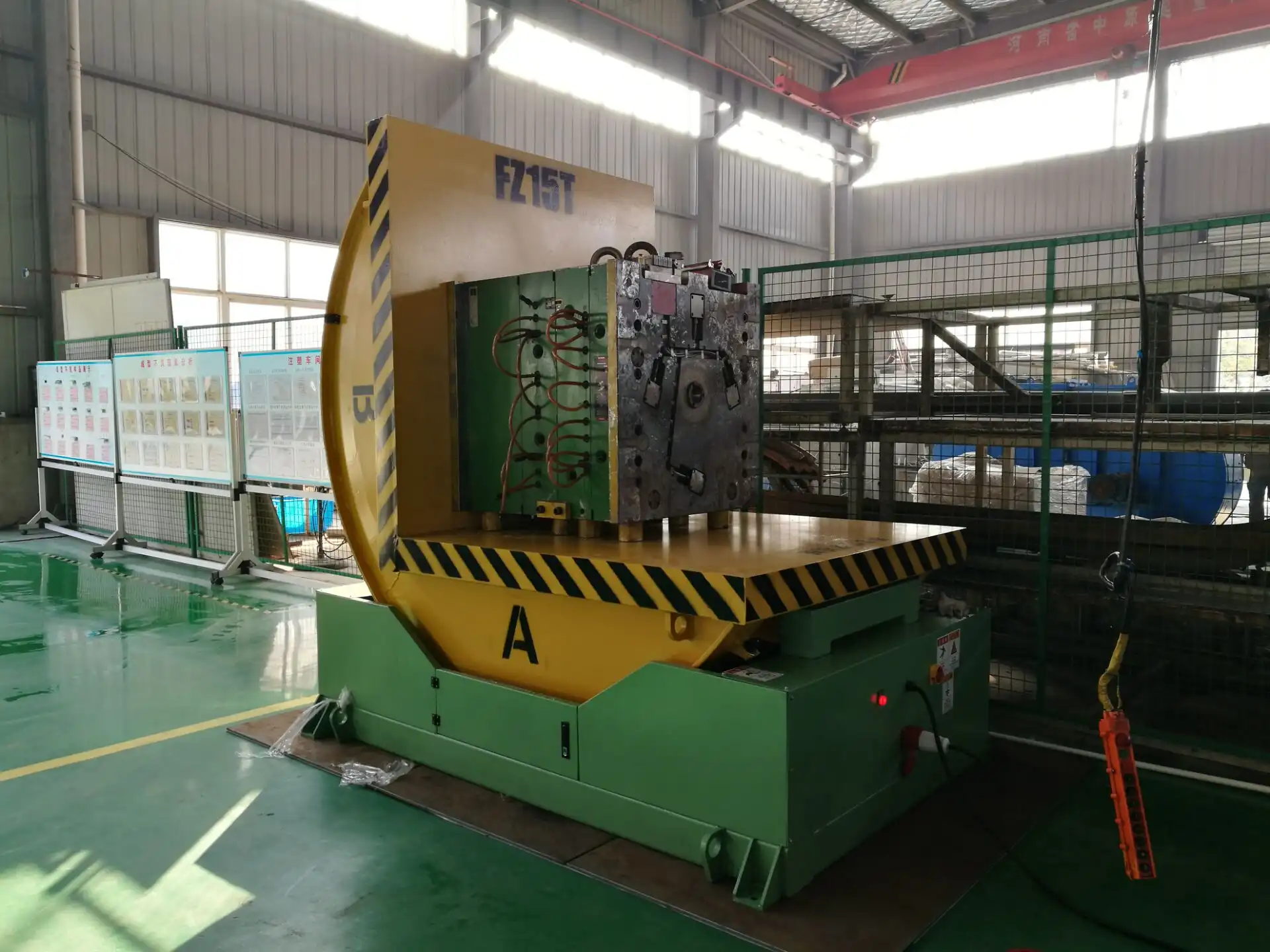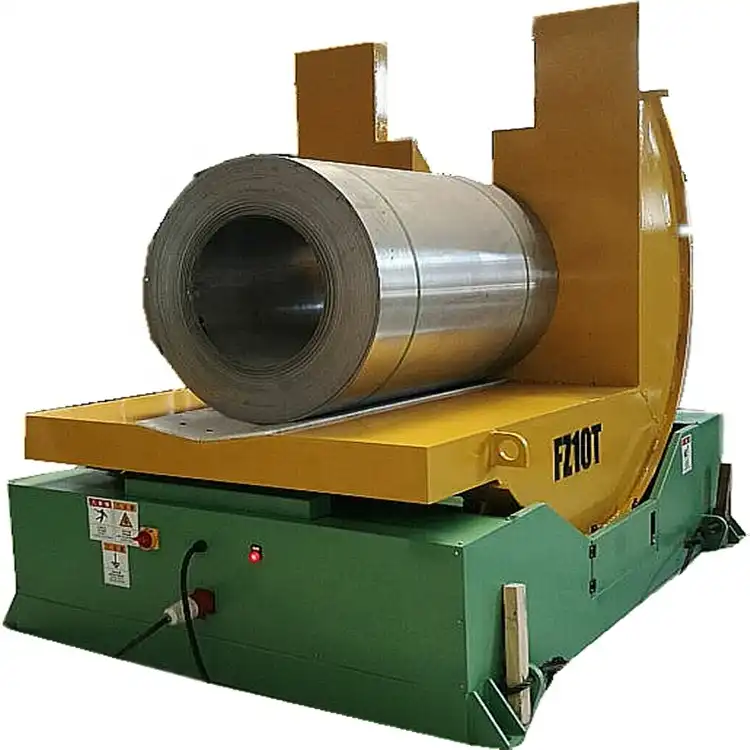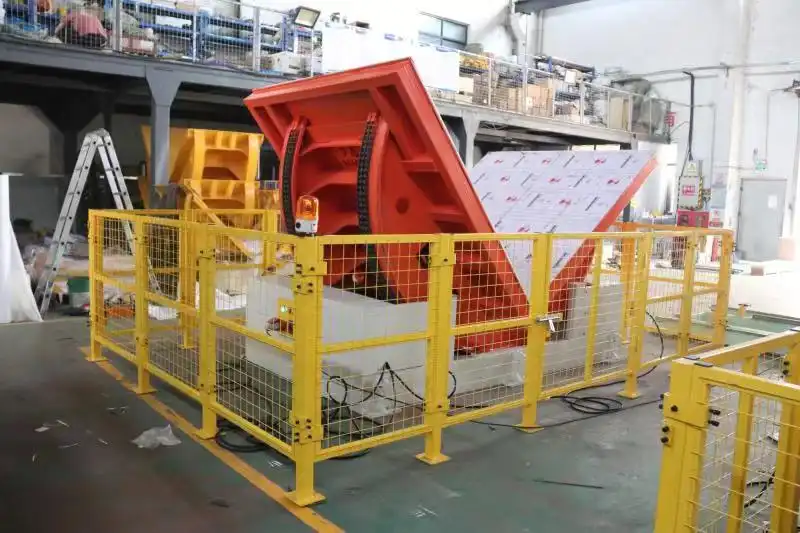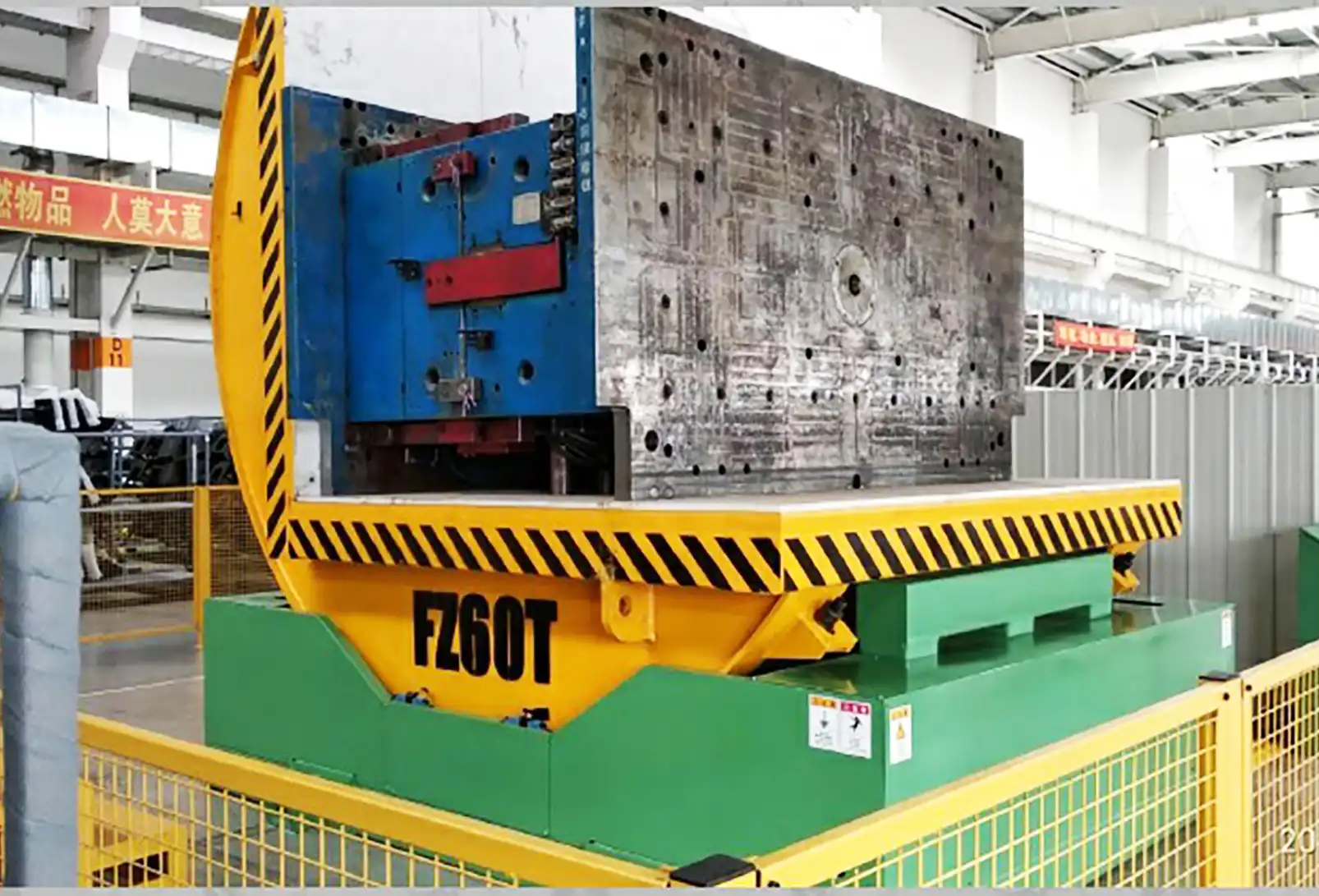Are you still relying on cranes and chains to flip heavy molds in your factory? This is often a slow and dangerous process. It puts your skilled workers at risk and ties up valuable equipment that could be used for production. For factory owners in industrial hubs across Colombia, from Bogotá to Medellín, every minute of inefficiency is a direct hit to the bottom line. Every near-miss accident is a potential disaster that could halt operations for days. You feel the constant pressure to improve safety while also cutting costs, but these goals can seem to conflict.
Modern mold tilting solutions are helping Colombian factories save significant labor costs by transforming a dangerous, multi-person manual task into a safe, efficient, one-person automated operation. These machines dramatically improve workplace safety, which reduces expenses related to accidents and downtime. They also free up skilled workers from simple material handling, allowing them to focus on more complex, value-adding jobs. This direct reallocation of labor and increased operational speed leads to clear, measurable cost savings and a boost in overall productivity.

This change is about more than just a new piece of machinery. It represents a fundamental shift in your operational philosophy, moving from outdated manual handling to modern, safe automation. As an engineer who has spent his entire career in and around packing and handling machinery, I’ve seen this transformation firsthand. Let's dig deeper into how these solutions work, the specific challenges they solve, and why they are becoming a critical investment for forward-thinking factory owners across Latin America.
What are the direct safety risks of traditional mold tilting?
You've likely seen the process countless times in your facility. A team of two or three workers gathers around a massive, multi-ton mold. They attach heavy chains or slings, communicating with the overhead crane operator through hand signals. As the mold lifts, it sways slightly. The team carefully guides it, trying to flip it over without it slipping or swinging uncontrollably. You probably hold your breath for a moment, hoping everything goes perfectly. But hope is not a safety strategy. A frayed sling, a moment of miscommunication, or an unbalanced load can lead to a catastrophic failure. These are not just abstract risks; they are real liabilities that can result in severe injuries, damaged equipment, and costly production stoppages.
The direct safety risks of traditional mold tilting stem from uncontrolled load movement and potential equipment failure. Using cranes and chains for a task they weren't designed for creates a high risk of swinging loads, dropped molds, and dangerous pinch points that can cause life-altering injuries or fatalities. Furthermore, the manual nature of the job leads to worker strain and fatigue, which significantly increases the chance of human error over time.

The Inherent Dangers of the Manual Process
When I first started my career, I visited a steel stamping plant that used this traditional method. The factory manager told me about a "near-miss" they had just a week earlier. A heavy stamping die slipped in its chains while being turned. It didn't fall completely, but it swung violently and crashed into a nearby CNC machine, causing thousands of dollars in damage. Luckily, no one was standing in that exact spot. That incident was the catalyst for them to invest in a dedicated mold tilter. The traditional method has several points of failure. The slings can be worn or improperly attached. The center of gravity of the mold can be misjudged, leading to an unbalanced and unpredictable flip. The workers on the ground are in a vulnerable position, right in the path of potential danger. The reliance on perfect communication between multiple people under pressure creates a system where a single mistake can have severe consequences.
Human Factor: The Unseen Cost of Manual Labor
Beyond the immediate risk of an accident, there is the long-term impact on your workforce. Manually guiding and wrestling with heavy loads, even with a crane's help, puts immense physical strain on workers. This leads to repetitive stress injuries, back problems, and general fatigue. A tired or sore worker is more likely to make a mistake. For a business leader like Javier Morales, who I know prioritizes both his people and his plant's stability, these ergonomic risks are a serious concern. They lead to increased absenteeism, higher worker compensation claims, and lower morale. These are all hidden costs that eat away at your profitability. A dedicated machine removes this physical strain entirely. The operator stands at a safe distance, controlling the entire process with the push of a button.
A Clear Comparison
Let's look at the risks side-by-side. This simple comparison makes the safety advantage of a dedicated tilter very clear.
| Safety Factor | Traditional Manual Tilting (Crane & Chains) | Modern Automated Mold Tilter |
|---|---|---|
| Risk of Dropping | High (depends on sling integrity, balance) | Extremely Low (mold is secured on a platform) |
| Pinch Points | High (workers guiding the load by hand) | Low (operator is at a safe distance) |
| Worker Strain | High (ergonomic risks, physical exertion) | None (fully mechanical operation) |
| Required Skill | High (requires experienced riggers & coordination) | Low (simple push-button operation) |
| Process Control | Low (potential for swinging, uncontrolled movement) | High (smooth, predictable, controlled motion) |
Moving to a modern solution is not just an upgrade in equipment; it's an upgrade in your factory's safety culture.
How does automation in mold tilters directly reduce operational expenses?
Every factory manager I speak with is tasked with reducing operational expenses. You've likely already targeted the big items like energy consumption and raw material waste. But sometimes, the most significant savings are hiding in plain sight, disguised as routine operational procedures. Think about the process of tilting a mold. You might need two or three skilled workers and an overhead crane to spend 20 or 30 minutes on this single task. During that time, those workers are not running machines or performing maintenance. The crane is not moving raw materials or finished products. This is non-value-added time, and it represents a direct, recurring operational cost that adds up quickly.
Automation in mold tilters directly attacks these operational expenses by drastically reducing both labor requirements and cycle times. The process is transformed from a slow, labor-intensive team effort into a quick, efficient task performed by a single operator in a fraction of the time. This frees up your skilled workers and your valuable crane capacity, allowing you to process more molds per shift and lowering the overall cost associated with your mold maintenance and changeover procedures.

A Simple Calculation of Labor Savings
The math is simple but powerful. Let's take a typical scenario in a Colombian factory. Suppose you pay a skilled worker a competitive wage, which includes salary and benefits. Tilting a mold manually might require three such workers for 30 minutes. An automated tilter requires one worker for about 5 minutes.
Let's break down the cost per tilt:
- Manual Method: 3 workers x 0.5 hours/tilt = 1.5 man-hours per tilt.
- Automated Method: 1 worker x (5/60) hours/tilt ≈ 0.08 man-hours per tilt.
The savings are over 90% in terms of man-hours for that specific task. If your factory re-tunes 10 molds per day, you are saving nearly 15 man-hours every single day. Over a year, this translates into thousands of hours of skilled labor that can be re-assigned to tasks that actually generate revenue, like operating production machinery, performing quality control, or conducting preventative maintenance. This is a direct reduction in your cost of goods sold and a direct increase in your profit margin.
The Ripple Effect of Increased Efficiency
The savings go beyond just direct labor. One of the biggest bottlenecks in many workshops I've visited is crane availability. When a crane is busy for 30 minutes carefully tilting a mold, it's not available for anything else. It can't be used to load a new steel coil onto a machine, move finished goods to the shipping area, or assist with urgent maintenance. This creates a production bottleneck that ripples through the entire factory floor. By reducing the tilting time to just a few minutes, the automated tilter frees up the crane almost immediately. This improved workflow and increased crane availability can have a massive impact on your factory's overall throughput and your ability to meet tight production schedules. For a steel mill owner like Javier, whose goal is to increase equipment uptime to 95%, eliminating these small, hidden delays is absolutely crucial.
Cost Comparison: A Clearer Picture
| Operational Metric | Manual Tilting (per tilt) | Automated Tilting (per tilt) |
|---|---|---|
| Workers Required | 2 - 3 | 1 |
| Cycle Time | 20 - 30 minutes | 3 - 5 minutes |
| Man-Hours | 1.0 - 1.5 hours | ~0.08 hours |
| Crane Occupancy | 20 - 30 minutes | 3 - 5 minutes |
| Risk of Mold Damage | Moderate | Very Low |
| Associated Labor Cost | High | Very Low |
The numbers speak for themselves. This isn't just about saving a few pesos on labor; it's about fundamentally optimizing your entire workflow to be faster, safer, and more profitable.
What integration challenges arise when upgrading to a modern mold tilter?
You've analyzed the safety and cost benefits and have decided that a modern mold tilter is the right move for your factory. The potential for improvement is exciting. But then, the practical questions start to surface. Where exactly will this new machine fit in my already crowded workshop? Will my existing electrical system support it? How difficult will it be to train my team to use it safely and effectively? A new piece of equipment, no matter how beneficial, can feel like a major disruption if the integration is not planned carefully. For a factory owner with established production lines and aging infrastructure, these concerns are valid and must be addressed.
The most common integration challenges when upgrading to a modern mold tilter involve three key areas: physical space and foundation requirements, compatibility with existing factory utilities like power and hydraulics, and the proper training and adoption by the operators. Successfully navigating these challenges requires a partnership approach with your supplier. It’s about more than just buying a machine; it's about planning a seamless installation that minimizes downtime and ensures the equipment works perfectly within your specific environment from day one.

Finding the Right Place: Space and Foundation
The first thing I always discuss with a client is the layout of their factory. We can't just drop a machine anywhere. I remember a project in Mexico where the client wanted a tilter right next to their main press. After we did a site survey, we realized the concrete floor in that specific area wasn't thick enough to support the dynamic load of the tilter and a 20-ton mold. We worked with them to identify a better location with a proper foundation, which also improved the overall flow of molds from the storage area to the maintenance shop.
Before you even order a machine, a proper site survey is essential. You need to consider:
- Footprint: The physical length, width, and height of the machine.
- Clearance: You need space around the machine for loading, unloading, and maintenance access.
- Material Flow: How will molds get to and from the tilter? Is the path clear for a forklift or overhead crane?
- Foundation: The concrete floor must be strong enough to handle the machine's weight plus the maximum weight of your molds. A good supplier should provide detailed foundation requirements.
Powering Up: Utility and System Connections
A new machine needs to plug into your factory's existing infrastructure. This can be a challenge, especially in older facilities where systems may be outdated. You need to verify compatibility with your electrical supply (voltage, phase, and available amperage). Does the machine require a hydraulic power pack, and if so, where will it be located?
Beyond power, think about safety system integration. Modern tilters come with safety features like light curtains, pressure-sensitive mats, or safety fences. These need to be integrated with your factory's overall safety protocols. The goal is to make the new machine a natural part of your existing safety ecosystem, not an isolated piece of equipment. This is where having a supplier who understands industrial controls and automation is key. They can help you ensure all systems communicate correctly.
The Human Element: Training for Success
Technology is only a solution if your people know how to use it properly. I've seen expensive, high-tech machines sit unused because the operators were not comfortable with them or weren't trained on proper maintenance. A successful integration must include a comprehensive training plan. This should include hands-on training for the operators, covering normal operation, safety procedures, and basic troubleshooting. It should also include training for your maintenance staff on preventative maintenance schedules, lubrication points, and how to diagnose common issues. As a supplier, I believe it's my responsibility to provide this training on-site and to supply clear, easy-to-understand manuals, preferably in the local language, like Spanish for our clients in Colombia and Mexico. A well-trained team is the final, and most important, step in a successful integration.
How can you calculate the ROI for a new mold tilting machine?
As a business owner, you scrutinize every significant capital expenditure. A new mold tilter might improve safety and efficiency, but you need to answer the most critical question: "What is the return on this investment?" The numbers must be clear and compelling. It can seem difficult to put a precise monetary value on benefits like improved safety or reduced operator stress. How do you calculate the cost of an accident that you successfully prevented? If you can't build a solid financial case, you can't justify the investment to your partners, your board, or yourself.
Calculating the Return on Investment (ROI) for a mold tilter is more straightforward than it appears. The process involves identifying and quantifying all the tangible annual cost savings and efficiency gains, and then comparing that to the total investment cost of the machine. By focusing on concrete numbers like reduced labor costs, increased production throughput, and the elimination of damage-related expenses, you can build a powerful business case that demonstrates the investment pays for itself, often much more quickly than you might expect.

Step 1: Quantify Your Annual Savings (S)
This is the most important part of the calculation. You need to add up all the money you will save or earn per year because of the new machine.
- Direct Labor Savings: This is the easiest to calculate. I showed the math earlier. Calculate the total saved man-hours per year and multiply by your average loaded labor rate (wage + benefits). For a factory in Colombia, this alone can amount to tens of thousands of dollars annually.
- Increased Throughput Value: How much more product can you make because of the efficiency gain? If freeing up your crane allows you to process two extra steel coils per day, what is the profit value of that extra production over a year? This is real, new revenue generated by removing a bottleneck.
- Reduced Damage Costs: Think back to my client's story about the die hitting a CNC machine. How often do minor incidents occur where molds or other equipment are scraped, dented, or damaged by manual handling? Assign an average annual cost to these incidents. A controlled, automated process reduces this cost to nearly zero.
- Avoided Accident Costs: While you can't predict an accident, you can use industry data. A single serious workplace injury can cost tens of thousands of dollars in medical bills, legal fees, and lost production. Even a conservative estimate of potential savings on insurance premiums or avoided costs can be included.
Step 2: Determine the Total Investment (I)
The investment is more than just the price on the quote. To get a true picture, you must calculate the Total Cost of Ownership (TCO).
- Purchase Price: The base cost of the machine.
- Shipping and Installation: The cost to get the machine to your factory in Colombia and have it professionally installed.
- Training Costs: The cost for on-site training for your operators and maintenance staff.
- Ancillary Costs: Any necessary foundation work or electrical upgrades.
Being honest and thorough here is important. A good supplier will be transparent about all these costs upfront.
Step 3: Calculate the Payback Period
The final calculation is simple: Payback Period (in years) = Total Investment (I) / Annual Savings (S).
Let's use a sample table with realistic figures.
| ROI Calculation Component | Example Value (USD) | Notes |
|---|---|---|
| Total Investment (I) | ||
| Machine Price | $50,000 | |
| Shipping & Installation | $5,000 | |
| Training | $2,000 | |
| Total (I) | $57,000 | Total one-time cost |
| Annual Savings (S) | ||
| Labor Savings | $25,000 | (e.g., 12 man-hours/day saved) |
| Increased Throughput | $15,000 | (Value of extra production) |
| Reduced Damage/Rework | $5,000 | |
| Total (S) | $45,000 | Total saved per year |
| Payback Period (I / S) | 1.27 Years | $57,000 / $45,000 |
A payback period of just over one year is a compelling financial argument. It shows that the machine is not a cost center, but a profit center. This is the kind of rigorous analysis that practical leaders like Javier Morales rely on to make smart, forward-looking decisions.
Conclusion
Modern mold tilters are more than equipment. They are strategic investments that boost safety, cut labor costs, and improve efficiency, securing a competitive edge for your factory's future.


